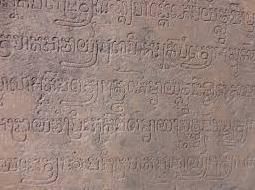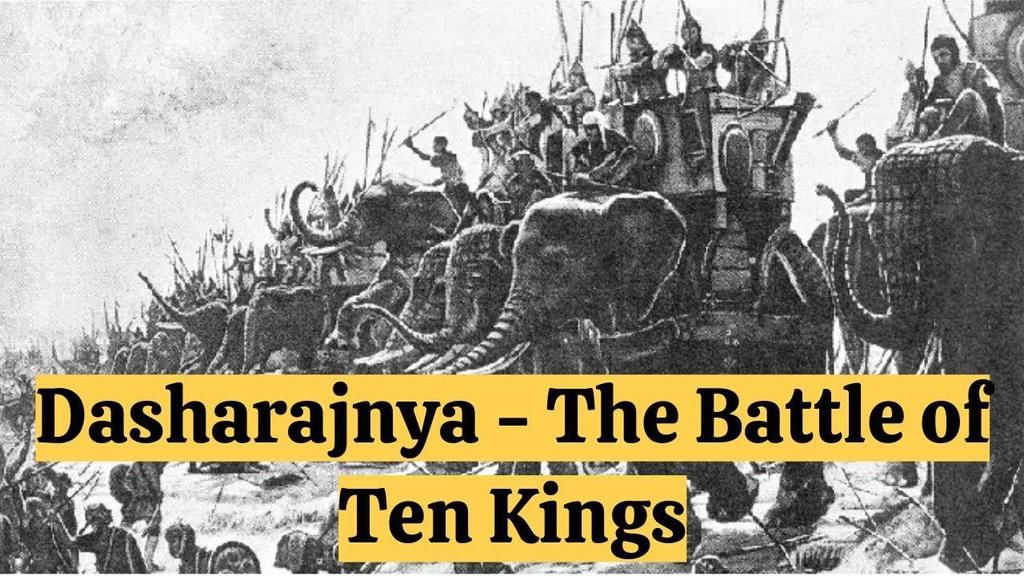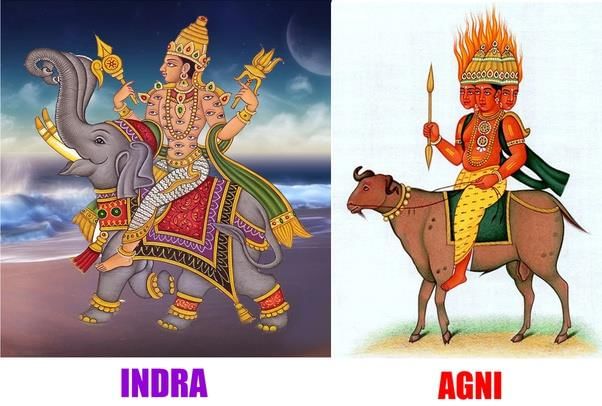UPSC Exam > UPSC Notes > History for UPSC CSE > Old NCERT Summary (RS Sharma): Advent of Aryans & Rig Vedic Period
Old NCERT Summary (RS Sharma): Advent of Aryans & Rig Vedic Period | History for UPSC CSE PDF Download
| Table of contents |

|
| Original Home and Identity |

|
| Tribal Conflicts |

|
| Material Life |

|
| Tribal Polity |

|
| Tribe and Family |

|
| Social Divisions |

|
| Rig Vedic Gods |

|
Original Home and Identity
- It is difficult to say that all the earliest Aryans belonged to one race, but their culture was more or less of the same type. They were distinguished by their common language.
 People in the Rigveda Period: Aryans
People in the Rigveda Period: Aryans - They spoke the Indo-European languages, which are currently in changed forms all over Europe, Iran, and the greater part of the Indian subcontinent. Originally the Aryans seem to have lived somewhere in the steppes stretching from southern Russia to Central Asia.
- Their earliest life seems to have been mainly postwar, with agriculture being a secondary occupation. Although the Aryans used several animals, the horse played the most significant role in their life. Its swiftness enabled them and some allied people to make successful inroads into the West. Asia from about 2000 B.C. onwards.
- On their way to India, Aryans first appeared in Central Asia and Iran, where the Indo-Iranians lived for a long time. We know about the Aryans in India from the Rig Veda. The term Arya occurs 36 times in this text and generally indicates a cultural community.
- The Rig Veda is the earliest text of the Indo-European languages. It is a collection of prayers offered to Agni, Indra, Mitra, Varun, and other gods by various families of poets or sages. It consists of ten mandalas or books, of which Books II to VII form its earliest portions. Books I and X seem to have been the latest additions.
- The Rig Veda has many things in common with the Avesta, which is the oldest text in the Iranian language. The two texts use the same names for several gods and even for social classes. But the earliest specimen of the Indo-European language is found in an inscription of about 2200 B.C. from Iraq. Later, such specimens occurred in Hittite inscriptions in Anatolia (Turkey) from the nineteenth to the seventeenth century B.C.
- Aryan names appear in Kassite inscriptions of about 1600 B.C. from Iraq, and in Mitanni, inscriptions of the fourteenth century B.C. from the Aryans appeared in India.
 Mitanni Inscription
Mitanni Inscription
- The earliest Aryans lived in the geographical area covered by eastern Afghanistan, North-West Frontier Province, Punjab, and fringes of western Uttar Pradesh. Some rivers of Afghanistan, such as the river Kubha and the river Indus and its five branches, are mentioned in the Rig Veda. The Sindhu, identical to the Indus, is the river par excellence of the Aryans, and it is repeatedly mentioned.
- Another river, the Saraswati, is called Naditama or the best of the rivers in the Rig Veda. The whole region where the Aryans first settled in the Indian subcontinent is called the Land of the Seven Rivers.
Question for Old NCERT Summary (RS Sharma): Advent of Aryans & Rig Vedic PeriodTry yourself:Where did the earliest Aryans originally live?
View Solution
Tribal Conflicts
- We hear of many defeats inflicted by Indra on the enemies of the Aryans. In the Rig Veda Indra is called Purandara, which means that he was the breaker of forts.
- The Aryans succeeded everywhere because they possessed chariots driven by horses and introduced them into West Asia and India. The Aryan soldiers were probably equipped also with coats of mail (Gaiman) and better arms.
 Aryans with Chariot
Aryans with Chariot
- According to tradition, the Aryans were divided into five tribes panchajana but there might have been other tribes also. The Bharatas and the Tritsu were the ruling Aryan clans, and they were supported by priest Vasisththa.
- The country Bharatavarsha was eventually named after the tribe Bharata, which appears first in the Rig Veda. The Bharata ruling clan was opposed by a host of ten chiefs, five of whom were heads of Aryan tribes and the remaining five of non-Aryan people. The battle that was fought between the Bharatas on the one hand and the host of ten chiefs on the other is known as the Battle of Ten Kings.

- This battle was fought on the river Parushni, identical to the river Ravi and it gave victory to Sudas and established the supremacy of the Bharatas. Of the defeated tribes, the most important was that of the Purus. Subsequently, the Bharatas joined hands with the Purus and formed a new ruling tribe called the Kurus. The Kurus combined with the Panchalas, and they together established their rule in the upper Gangetic basin, where they played an important part in later Vedic times.
Material Life
- The Rig Vedic people possessed better knowledge of agriculture. Ploughshare is mentioned in the earliest part of the Rig Veda though some consider it an interpolation. Possibly this ploughshare was made of wood. They were acquainted with sowing, harvesting, and threshing and knew about the different seasons.
- Despite all this, there are so many references to the cow and the bull in the Rig Veda that the Rig Vedic Aryans can be called predominantly pastoral people. Most of their wars were fought for the sake of cows. The term for war in the Rig Veda is gavishthi or search for cows. The cow seems to have been the most important form of wealth. The Rig Veda mentions such artisans as the carpenter, the chariot-maker, the weaver, the leather worker, the potter, etc.
- This indicates that they practised all these crafts. The term ayas, used for copper or bronze, shows that metalworking was known. But we have no clear evidence of the existence of regular trade. The Aryans or the Vedic people were acquainted more with land routes because the word Samudra mentioned in the Rig Veda mainly denotes a collection of water. We may, therefore, have this of a pre-iron phase of the PGW, which coincided with the Rig Vedic phase.
Tribal Polity
- The administrative machinery of the Aryans in the Rig period worked with the tribal chief in the centre because of his successful leadership in war. He was called Rajan.
- It seems that in the Rig Vedic period, the king’s post had become hereditary. We have traces of the election of the king by the tribal assembly called the Samiti. The king was called the protector of his tribe.
- Several tribal or clan-based assemblies, such as the sabha, samiti, vidatha, and gana are mentioned in the Rig Veda. They exercised deliberative, military, and religious functions. Even women attended the sabha and vidatha in Rig Vedic times. But the two most important assemblies were the Sabha and the Samiti. These two were so important that the chiefs or the kings showed eagerness to win their support.
- In the day-to-day administration, the king was assisted by a few functionaries. The most important function seems to have been the purohita.
 Sage Vasishtha
Sage Vasishtha
- The two priests who played a major part in the time of Rig Veda were Vashishta and Vishwamitra. Vishwamitra composed the Gayatri mantra to widen the Aryan world. The next important functionary seems to be the senani, who used spears, axes, swords, etc. We do not come across any officer concerned with the collection of taxes.
- Probably the chiefs received from the people voluntary offerings called Bali. Presents and spoils of war were perhaps distributed in some Vedic assemblies. The Rig Veda does not mention any officer for administering justice. Spies were employed to keep an eye on such unsocial activities.
- The officer who enjoyed authority over a large land or pasture ground is called Vrajapati. He led heads of the families called kulapas, or the heads of the fighting hordes called graminis to battle.
- In the beginning, the grammar was just the head of a small tribal fighting unit. But when the unit settled, the gramani became the head of the village, and in the course of time, he became identical to the Vrajapati. The king did not maintain any regular or standing army, but in times of war, he mustered a militia whose military functions were performed by different tribal groups called vrata, gana, grama, and sardha. By and large, it was a tribal system of government in which the military element was strong.
Question for Old NCERT Summary (RS Sharma): Advent of Aryans & Rig Vedic PeriodTry yourself: Which tribe was the ruling Aryan clan during the Battle of Ten Kings?View Solution
Tribe and Family
- Kinship was the basis of social structure, and a man was identified by the clan to which he belonged. People gave their primary loyalty to the tribe, which was called Jana. The term jana occurs at about 275 places in the Rig Veda, and the term janapada or territory is not used even once. The people were attached to the tribe since the territory or the kingdom was not yet established.
- Another important term that stands for the tribe in the Rig Veda is vis, it is mentioned 170 times in that text. Probably the vis was divided into grama or smaller tribal units meant for fighting. When the gramas clashed with one another, it caused samgrama. The most numerous varna of vaishya arose out of the vis or the mass of the tribal people.
- The term for family (kula) is mentioned rarely in the Rig Veda. It comprised not only mothers, fathers, sons, slaves, etc., but many more people. It seems that family in the early Vedic phase was indicated by the term griha, which frequently occurs in this text. In the earliest Indo-European languages, one word is used for nephew, grandson, cousin, etc. It seems that several generations of the family lived under the same roof. Because it was a patriarchal society, the birth of a son was desired again and again, and people especially prayed to the gods for brave sons to fight the wars.
- In the Rig Veda, no desire is expressed for daughters, though the desire for children and cattle is a recurrent theme in the hymns. Women could attend assemblies. They could offer sacrifices along with their husbands. We have an instance of five women who composed hymns, although the later texts mention 20 such women.
- We also notice the practice of levirate and widow remarriage in the Rig Veda. There are no examples of child marriage, and the marriageable age in Rig Veda seems to have been 16 to 17.
Social Divisions
- The Rig Veda mentions Arya varna and Dasa varna. The tribal chiefs and the priests acquired a larger share of the booty, and they naturally grew at the cost of their kinsmen, which created social inequalities in the tribe. Gradually the tribal society was divided into three groups - warriors, priests, and the people - on the same pattern as in Iran. The fourth division called the Shudras, appeared towards the end of the Rig Vedic period because it is mentioned for the first time in the tenth Book of the Rig Veda, which is the latest addition.
- In the age of the Rig Veda, differentiation based on occupations had started. But this division was not very sharp. We hear of a family where a member says: “I am a poet, my father is a physician, and my mother is a grinder. Earning livelihood through different means, we live together”. We hear of gifts of cattle, chariots, horses, slaves, etc.
- Unequal distribution of the spoils of war created social inequalities, which helped the rise of princes and priests at the cost of the common tribal people. However, since the economy was mainly pastoral and not food-producing, the scope for collecting regular tributes from the people was very limited. We do not find gifts of land, and even those of cereals are rare. We find domestic slaves but not wage-earners.
- Tribal elements in society were stronger and social divisions based on the collection of taxes or accumulation of landed property were absent. The society was still tribal and largely egalitarian.
Rig Vedic Gods
- The most important divinity in the Rig Veda is Indra, which is called Purandara or the breaker of forts. Indra played the role of a warlord, leading the Aryan soldiers to victory against the demons. Two hundred and fifty hymns are devoted to him. He is considered to be the rain god and thought to be responsible for causing rainfall.

- The second position is held by Agni (fire god) to whom 200 hymns are devoted. Fire played a significant part in the life of primitive people because of its use in burning forests, cooking, etc. The cult of fire occupied a central place not only in India but also in Iran, In Vedic times, Agni acted as a king of intermediary between the gods on the one hand and the people on the other.
- The third important position is occupied by Varuna, who personified water. Varuna was supposed to uphold the natural order, and whatever happened in the world was thought to be the reflection of his desires.
 Varuna
Varuna - Soma was considered to be the god of plants and an intoxicating drink is named after him. The Maruts personify the storm. We have a large number of gods., who represent the different forces of nature in one form or another but are also assigned human activities. We also find some female divinities, such as Aditi and Ushas, who represent the appearance of the dawn. But they were not prominent in the time of the Rig Veda in the set-up of the period the male gods were far more important than the female.
- The dominant mode of worshipping the dos was through the recitation of prayers and offering of sacrifices. Prayers played an important part in Rig Vedic times. Both collective and individual prayers were made.
- Originally every tribe or clan was the votary of a special god. It seems that prayers were offered to gods in chorus by the members of a whole tribe. This also happened in the case of sacrifices. Agni and Indra were invited to partake in sacrifices made by the whole tribe (Jana). Offerings of vegetables, grain, etc., were made to gods.
- But in Rig Vedic times, the process was not accompanied by any ritual or sacrificial formulae. They asked mainly for Praja (children), Pashu (cattle), food, wealth, health, etc.
Question for Old NCERT Summary (RS Sharma): Advent of Aryans & Rig Vedic PeriodTry yourself: In the Rig Veda, what was the basis of social structure?View Solution
The document Old NCERT Summary (RS Sharma): Advent of Aryans & Rig Vedic Period | History for UPSC CSE is a part of the UPSC Course History for UPSC CSE.
All you need of UPSC at this link: UPSC
|
210 videos|855 docs|219 tests
|
FAQs on Old NCERT Summary (RS Sharma): Advent of Aryans & Rig Vedic Period - History for UPSC CSE
| 1. What were some of the key aspects of the original home and identity of the Aryans during the Rig Vedic period? |  |
Ans. The original home and identity of the Aryans during the Rig Vedic period were characterized by tribal conflicts, material life centered around agriculture and cattle rearing, tribal polity, strong emphasis on the tribe and family, social divisions, and the worship of Rig Vedic Gods.
| 2. How did tribal conflicts impact the Aryans during the Rig Vedic period? |  |
Ans. Tribal conflicts were a significant aspect of Aryan society during the Rig Vedic period, leading to competition for resources, power struggles, and the development of a sense of identity and solidarity within each tribe.
| 3. What role did social divisions play in Aryan society during the Rig Vedic period? |  |
Ans. Social divisions were prevalent in Aryan society during the Rig Vedic period, with distinctions based on factors such as occupation, wealth, and lineage. These divisions influenced social interactions, power dynamics, and the overall structure of Aryan society.
| 4. How did the Rig Vedic Gods shape the religious beliefs and practices of the Aryans? |  |
Ans. The Rig Vedic Gods played a central role in Aryan religious beliefs and practices, with each god representing different aspects of nature, life, and society. The Aryans worshipped these gods through rituals, sacrifices, and prayers to seek their blessings and protection.
| 5. What was the significance of the tribe and family in Aryan society during the Rig Vedic period? |  |
Ans. The tribe and family held great importance in Aryan society during the Rig Vedic period, serving as the primary units of social organization, economic cooperation, and political allegiance. Strong familial and tribal ties helped maintain social cohesion and stability within Aryan communities.
Related Searches
















